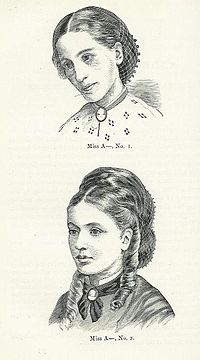
Photo from wikipedia
Abstract Digital dermatitis (DD) is an infectious skin disease and a major cause of lameness that significantly impacts cattle productivity and welfare. However, DD does not always result in lameness… Click to show full abstract
Abstract Digital dermatitis (DD) is an infectious skin disease and a major cause of lameness that significantly impacts cattle productivity and welfare. However, DD does not always result in lameness and lameness scoring systems are not specific to hoof pathologies. Digital dermatitis detection protocols could be improved by including gait traits most related to DD. The aims of this study were to 1) determine the association between DD M-stage (“M” for Mortellaro), locomotion, and gait traits: arched back (AB), asymmetric gait (AG), head bobbing (HB), tracking up (TU), and reluctance to bear weight (WB), and 2) determine which traits are most associated with DD. Cattle (n = 480) from three feedlots were enrolled. Locomotion score (LS) and gait traits were assessed as cattle walked four strides along a dirt alleyway. Next, cattle were restrained in a chute, each hind foot lifted, and DD M-stage (absent, active, or chronic) determined. The association between presence of DD, LS, and gait traits were scored independently (n = 291). For both LS and gait the lowest score represents normal and the highest score severely altered. Digital dermatitis presence was associated with higher LS (P < 0.001). Odds ratios (ORs) for cattle with DD being lame or moderately to severely lame were 8.0 (P < 0.001) and 10.1 (P < 0.001) times more than cattle without lesions. Cattle with active lesions had the greatest odds of being lame (OR = 9.4; P < 0.001). Digital dermatitis presence was associated with all gait traits (P < 0.001), where AG (OR = 5.5; P < 0.001) and WB (OR = 5.8; P < 0.001) had the greatest OR for classifying cattle with DD as having altered gait. The OR for cattle with active lesions having altered gait was greatest for WB which was 6.0 (P < 0.001) times greater than cattle without lesions. The OR for cattle with chronic lesions having altered gait was greatest for AG being 6.5 (P < 0.001) times more than cattle without lesions. All gait traits had low sensitivity (Se) for detecting cattle with DD and varied from 6.7% to 55.8%. Locomotion score (Se 55.8%) and AG (Se 44.2%) were most predictive with positive predictive values of 76.6% and 74.3%, respectively. Specificity for all traits ranged from 94.1% for LS to 98.4% for WB with negative predictive values of 72.1% and 68.9%, respectively. In conclusion, LS, WB, and AG had the strongest association with cattle that had DD. Locomotion scoring that includes a focus on WB and AG is the best tool to detect DD in beef cattle.
Journal Title: Journal of Animal Science
Year Published: 2022
Link to full text (if available)
Share on Social Media: Sign Up to like & get
recommendations!